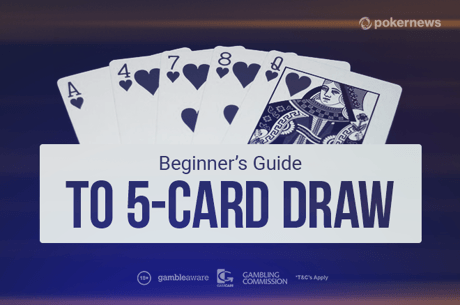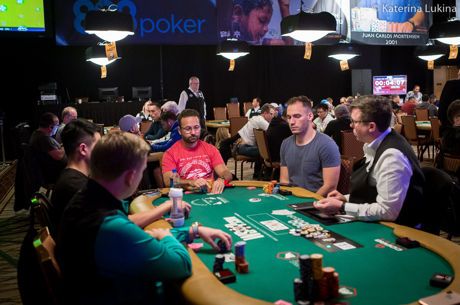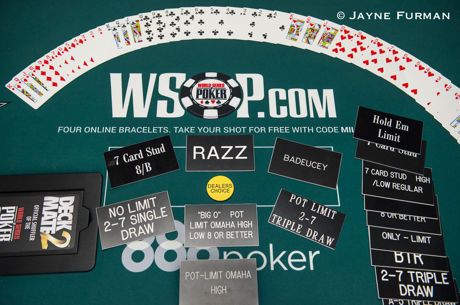Talking HORSE with Lou Krieger, Vol. 3: Adjusting to Fixed-limit Games

HORSE, as pointed out previously, is an unbalanced game because most competitors are primarily Texas hold’em players who might be erring by playing only off their own strength. Money won or lost in poker is primarily a function of relative skill differentials and how well you play compared to your opponent. It’s not just about how well you play against some abstract standard.
HORSE is also unbalanced in the sense that Omaha/8 and 7-stud/8 are split-pot games, while hold’em, razz, and 7-card stud are designed to produce a single winner per hand, even if there’s an occasional split pot.
There’s a third perspective too, although it’s more subtle than the others and tends to be a function of a player’s style and orientation, not his or her skill level.
For the many poker players who have come to the game in the years since 2003 — when online poker and televised tournaments combined to make poker as popular as it currently is — poker means one thing, and one thing only: no-limit hold’em. It’s the only game many of these players know. They play it exclusively; they play it well; and they don’t have much experience with any of the other games in the HORSE rotation, nor do they have much experience playing fixed-limit hold’em.
While fixed-limit and no-limit hold’em may look similar, the underpinnings are different because the wagering structure lends itself to radically different strategies. Fixed- and no-limit hold’em are as different as arena football is from the outdoor game, or as different as three-on-three, half-court basketball is from a full court game.
Choosing the right starting hands is just as important in fixed-limit hold’em as it is in a no-limit game, but there are significant differences in the kind of hands you should consider playing. Most no-limit players are in search of starting hands that can grow very big and afford the holder an opportunity to take an opponent’s entire stack. In a fixed-limit game, that’s not the case at all. The trick in fixed-limit hold’em is to push every small edge, because profit comes from small, repetitive edges, played time after time. To succeed in fixed-limit games, you have to base your choice of starting hands accordingly.
Here are some examples. A hand such as K-J figures to make top pair with a good side card and show a profit in fixed limit games when it does. Under the right circumstances, K-J can even be played for a raise before the flop. But in a no-limit game, you’re not after hands that figure to make one pair with a big kicker; you want hands that will allow you to go after all of an opponent’s chips in one fell swoop.
A pocket pair of sixes is vulnerable in a fixed-limit game because the flop will almost always contain cards bigger than your pair, and any opponent holding cards ranked higher than six can easily wind up with a bigger pair than yours. While the odds against flopping a set are 7.5-to-1 regardless of whether you’re in a fixed- or a no-limit game, the payoff for flopping a set in a fixed-limit game is usually not sizeable enough to justify bucking those odds.
Choosing a starting hand in no-limit hold’em is more often related to chip counts and your position in the betting order than anything else. No-limit hold’em is all about implied odds, the money you figure to win if you get lucky and make a big hand. The more you and your opponent each have in front of you, the more you should be willing to take a flyer on hands that will probably be unceremoniously tossed away on the flop, yet have the potential to grow very large indeed — and will enable you to win a huge pot when they do.
This is very different than fixed-limit hold’em, and here’s where no-limit players need to make a big adjustment in their strategic thinking. In fixed-limit, it’s no longer a case of trying to take an opponent’s entire stack. In fact, if he has a sufficiently tall stack, that’s tough or even impossible to do when the betting limits are prescribed by the rules of the game. Instead, good fixed-limit players are looking for small edges in high volume pots.
In no-limit hold’em, hand selection is driven by the chips you and your opponent each have available for play, and how willing your opponent is to commit all or most of his chips with something less than the best possible hand. And position is paramount in no-limit. Position guarantees that you bat last. Whenever you act after your adversary, you can play any number of hands he can’t afford to, secure in the fact that your bet will force him to release his hand more often than not.
Position is important in a fixed-limit game too. But at least the guy who goes first in a fixed-limit game knows precisely how much his opponent can bet if he decides to bet at all, and the early-to-act player can predicate his play-or-fold strategy on that knowledge. In a no-limit game it’s a lot easier to drive an opponent off a hand — particularly a drawing hand — by betting enough so that the payoff odds associated with the cost of calling a wager don’t offset the mathematical odds against completing a hand.
Tournaments are different beasts altogether, and the decision to play or fold — even in fixed-limit HORSE tournaments — or to bet, call, or raise, frequently depend on the relationship between the size of your stacks and the blinds and antes that comprise the cost to play a hand.
When you’re short-stacked, hands like that proverbial pair of sixes might look good because you’re close to going all in anyway, and you can’t wait around hoping to be dealt a pocket pair of aces, kings, or queens. If you do, you’re likely to bleed to death. And even if you are blessed with a big pocket pair somewhere down the road, you might not have enough chips in your arsenal to make much of a difference even if you do win that pot.
But for no-limit hold’em players looking to jump in and mix it up in a fixed-limit HORSE game, it’s critically important to develop a set of starting standards so you are able to see the flop with some long-term positive expectation.
If you have a set of starting hand standards in mind, you can compare them to standards I’ve written about in some of my books, or those that David Sklansky has suggested in his, or standards other authors have suggested for fixed-limit cash game play.
Although most of the suggested starting standards were developed for limit Texas hold’em, you need to find some starting hands for Omaha/8, razz, 7-card stud, and 7-stud/8 too. If you are skilled and successful in any of these games, you can probably perpetuate that success just by doing what you’re doing now. But if you are not successful, or tend to get lost in hands during games you seldom play, a set of starting standards will ensure that you will always know where you are, and save you some money in the process because you’ll know when to continue on with a hand or dump it.
For no-limit players, HORSE demands a change of mindset if for no other reason than fixed-limit poker and no-limit poker are different games entirely.
# # #
Lou Krieger is the editor of Poker Player Newspaper. He’s the author of more than 400 articles on poker strategy and 11 books on poker. He can also be heard on the internet radio show, “Keep Flopping Aces” which airs Thursday night at 9 p.m. Eastern Time (6 p.m. Pacific) on www.roundersradio.com.









